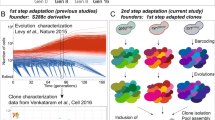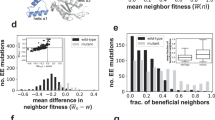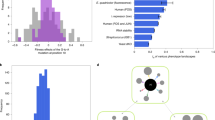Abstract
Robustness seems to be the opposite of evolvability. If phenotypes are robust against mutation, we might expect that a population will have difficulty adapting to an environmental change, as several studies have suggested1,2,3,4. However, other studies contend that robust organisms are more adaptable5,6,7,8. A quantitative understanding of the relationship between robustness and evolvability will help resolve these conflicting reports and will clarify outstanding problems in molecular and experimental evolution, evolutionary developmental biology and protein engineering. Here we demonstrate, using a general population genetics model, that mutational robustness can either impede or facilitate adaptation, depending on the population size, the mutation rate and the structure of the fitness landscape. In particular, neutral diversity in a robust population can accelerate adaptation as long as the number of phenotypes accessible to an individual by mutation is smaller than the total number of phenotypes in the fitness landscape. These results provide a quantitative resolution to a significant ambiguity in evolutionary theory.
This is a preview of subscription content, access via your institution
Access options
Subscribe to this journal
Receive 51 print issues and online access
We are sorry, but there is no personal subscription option available for your country.
Buy this article
- Purchase on SpringerLink
- Instant access to full article PDF
Prices may be subject to local taxes which are calculated during checkout



Similar content being viewed by others
References
Ancel, L. W. & Fontana, W. Plasticity, evolvability, and modularity in RNA. J. Exp. Zool. 288, 242–283 (2000)
Carter, A. J. R., Hermisson, J. & Hansen, T. F. The role of epistatic gene interactions in the response to selection and the evolution of evolvability. Theor. Popul. Biol. 68, 179–196 (2005)
Cowperthwaite, M. C., Economo, E. P., Harcombe, W. R., Miller, E. L. & Meyers, L. A. The ascent of the abundant: how mutational networks constrain evolution. PLoS Comput. Biol. 4, e1000110 (2008)
Parter, M., Kashtan, N. & Alon, U. Facilitated variation: how evolution learns from past environments to generalize to new environments. PLoS Comput. Biol. 4, e1000206 (2008)
Bloom, J. D., Labthavikul, S. T., Otey, C. R. & Arnold, F. H. Protein stability promotes evolvability. Proc. Natl Acad. Sci. USA 103, 5869–5874 (2006)
Aldana, M., Balleza, E., Kauffman, S. & Resendiz, O. Robustness and evolvability in genetic regulatory networks. J. Theor. Biol. 245, 433–448 (2007)
Elena, S. F. & Sanjuan, R. The effect of genetic robustness on evolvability in digital organisms. BMC Evol. Biol. 8, 284 (2008)
McBride, R. C., Ogbunugafor, C. B. & Turner, P. E. Robustness promotes evolvability of thermotolerance in an RNA virus. BMC Evol. Biol. 8, 231 (2008)
de Visser, J. A. G. M. et al. Evolution and detection of genetic robustness. Evolution 57, 1959–1972 (2003)
Lenski, R. E., Barrick, J. E. & Ofria, C. Balancing robustness and evolvability. PLoS Biol. 4, e428 (2006)
Wagner, A. Robustness and evolvability: a paradox resolved. Proc. R. Soc. B 275, 91–100 (2008)
Rutherford, S. L. & Lindquist, S. Hsp90 as a capacitor for morphological evolution. Nature 396, 336–342 (1998)
Bergman, A. & Siegal, M. L. Evolutionary capacitance as a general feature of complex gene networks. Nature 424, 549–552 (2003)
Kirschner, M. & Gerhart, J. The Plausibility of Life: Resolving Darwin’s Dilemma (Yale Univ. Press, 2005)
Wagner, A. Robustness and Evolvability in Living Systems (Princeton Univ. Press, 2005)
Meyers, L., Ancel, F. & Lachmann, M. Evolution of genetic potential. PLoS Comput. Biol. 1, e32 (2005)
van Nimwegen, E. Influenza escapes immunity along neutral networks. Science 314, 1884–1886 (2006)
Blount, Z. D., Borland, C. Z. & Lenski, R. E. Historical contingency and the evolution of a key innovation in an experimental population of Escherichia coli . Proc. Natl Acad. Sci. USA 105, 7899–7906 (2008)
Fontana, W. & Schuster, P. Continuity in evolution: on the nature of transitions. Science 280, 1451–1455 (1998)
Ciliberti, S., Martin, O. C. & Wagner, A. Innovation and robustness in complex regulatory gene networks. Proc. Natl Acad. Sci. USA 104, 13591–13596 (2007)
Sumedha, O. C. & Wagner, A. New structural variation in evolutionary searches of RNA neutral networks. Biosystems 90, 475–485 (2007)
Koelle, K., Cobey, S., Grenfell, B. & Pascual, M. Epochal evolution shapes the phylodynamics of interpandemic influenza a (H3N2) in humans. Science 314, 1898–1903 (2006)
Cambray, G. & Mazel, D. Synonymous genes explore different evolutionary landscapes. PLoS Genet. 4, e1000256 (2008)
Isalan, M. et al. Evolvability and hierarchy in rewired bacterial gene networks. Nature 452, 840–845 (2008)
van Nimwegen, E., Crutchfield, J. & Huynen, M. Neutral evolution of mutational robustness. Proc. Natl Acad. Sci. USA 96, 9716–9720 (1999)
Forster, R., Adami, C. & Wilke, C. O. Selection for mutational robustness in finite populations. J. Theor. Biol. 243, 181–190 (2006)
Daniels, B. C., Chen, Y.-J., Sethna, J. P., Gutenkunst, R. N. & Myers, C. R. Sloppiness, robustness, and evolvability in systems biology. Curr. Opin. Biotechnol. 19, 389–395 (2008)
Wilds, R., Kauffman, S. A. & Glass, L. Evolution of complex dynamics. Chaos 18, 033109 (2008)
Wilke, C. O., Wang, J. L., Ofria, C., Lenski, R. E. & Adami, C. Evolution of digital organisms at high mutation rates leads to survival of the flattest. Nature 412, 331–333 (2001)
Krakauer, D. C. & Plotkin, J. B. Redundancy, antiredundancy, and the robustness of genomes. Proc. Natl Acad. Sci. USA 99, 1405–1409 (2002)
Acknowledgements
We thank P. Turner and members of the Plotkin laboratory for advice and feedback. J.B.P. acknowledges funding from the Burroughs Wellcome Fund, the David and Lucile Packard Foundation, the James S. McDonnell Foundation, the Alfred P. Sloan Foundation, the Defense Advanced Research Projects Agency (HR0011-05-1-0057) and the US National Institute of Allergy and Infectious Diseases (2U54AI057168). G.P.W. acknowledges funding from the John Templeton Foundation and the Perinatology Research Branch of the US National Institutes of Health.
Author Contributions J.A.D., J.B.P. and G.P.W. designed the project. J.A.D. and J.B.P. wrote the paper; G.P.W. and T.L.P. edited the paper. J.A.D. performed the simulations. T.L.P. performed most of the analysis, with contributions from J.B.P. and J.A.D. J.A.D., T.L.P. and J.B.P. wrote the Supplementary Information.
Author information
Authors and Affiliations
Corresponding author
Ethics declarations
Competing interests
The authors declare no competing financial interests.
Supplementary information
Supplementary Information
This file contains Supplementary Data, Supplementary Figures 1-12 with Legends, Supplementary Table1 and Supplementary References. (PDF 830 kb)
Rights and permissions
About this article
Cite this article
Draghi, J., Parsons, T., Wagner, G. et al. Mutational robustness can facilitate adaptation. Nature 463, 353–355 (2010). https://doi.org/10.1038/nature08694
Received:
Accepted:
Issue Date:
DOI: https://doi.org/10.1038/nature08694
This article is cited by
-
Phenotype Design Space Provides a Mechanistic Framework Relating Molecular Parameters to Phenotype Diversity Available for Selection
Journal of Molecular Evolution (2023)
-
Early effects of gene duplication on the robustness and phenotypic variability of gene regulatory networks
BMC Bioinformatics (2022)
-
Selection in a growing colony biases results of mutation accumulation experiments
Scientific Reports (2022)
-
A biological perspective on evolutionary computation
Nature Machine Intelligence (2021)
-
Large-scale in silico mutagenesis experiments reveal optimization of genetic code and codon usage for protein mutational robustness
BMC Biology (2020)



